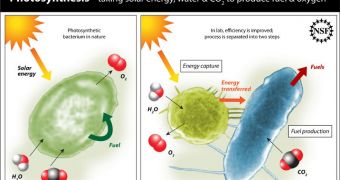A collaboration of researchers has recently been awarded a large grant for studying methods that could lead to improvements in the process of biological photosynthesis. Making this process more efficient could lead to more affordable renewable energy, and also to better, cheaper biofuels.
The funds, totaling around $10.3 million, were provided jointly by the US National Science Foundation (NSF) and the Biotechnology and Biological Sciences Research Council (BBSRC), in the UK.
According to experts at the two organizations, the money were awarded to four research groups, each of which will be responsible for clearing a single bottleneck researchers in this field are faced with.
Experts in these groups will have three years at their disposal to finish their researches using the NSF/BBSRC funds. By the time the project ends, we will undoubtedly have gained a deeper understanding of photosynthesis.
The process is critically-important for nature, and is one of the main reasons why complex lifeforms, such as ourselves, exist today. It works by converting sunlight and carbon dioxide plants remove from the atmosphere into oxygen and energy that is then used to power up the plant's cells.
“Photosynthesis is essential for life on Earth. By providing food and generating oxygen, it has made our planet hospitable for life,” says Joann Roskoski, who is the acting assistant director for the NSF Division of Biological Sciences.
“This process is also critical in addressing the food and fuel challenges of the future. For decades, NSF has invested in photosynthesis research projects that range from biophysical studies to ecosystem analyses at a macroscale,” the expert adds.
“The Ideas Lab in photosynthesis was an opportunity to stimulate and support different types of projects than what we have in our portfolio in order to address a critical bottleneck to enhancing the photosynthetic process,” Roskoski says.
The first project to receive funding will be conducted at the Arizona State University (ASU), and will be led by expert Anne Jones. Its goal is to separate the capture and conversion of solar energy into fuel from a single process into two processes, featuring two different, communicating microorganisms.
University of Illinois experts, led by Stephen Long, will attempt to improve plant photosynthesis efficiency by exploiting prokaryotic proteins. In order to achieve this goal, they will use protein structures called carboxysomes, which are found in blue-green algae.
The third project will be conducted at Pennsylvania State University under the leadership of John Golbeck. Its goal will be to develop multi-level approaches for generating carbon dioxide. Larger amounts of CO2 inside microorganisms will boost their photosynthesis rates considerably.
Martin Jonikas, at the Stanford University, will conduct the fourth project, who goal is to combine the photosynthesis abilities of algae and plants. It is expected that this endeavor will provide algae-plant combinations with tremendously efficient photosynthesis rates.
“Photosynthesis has evolved in plants, algae and some other bacteria and in each case the mechanism does the best possible job for the organism in question,” says Janet Allen, research director at BBSRC.
“However, there are trade-offs in nature which mean that photosynthesis is not as efficient as it could be--at around only five percent, depending on how it is measured,” she explains.
“There is scope to improve it for processes useful to us by, for example, increasing the amount of food crop or energy biomass a plant can produce from the same amount of sunlight,” the official adds.
“This is hugely ambitious research but if the scientists we are supporting can achieve their aims it will be a profound achievement,” Allen concludes.

 14 DAY TRIAL //
14 DAY TRIAL //